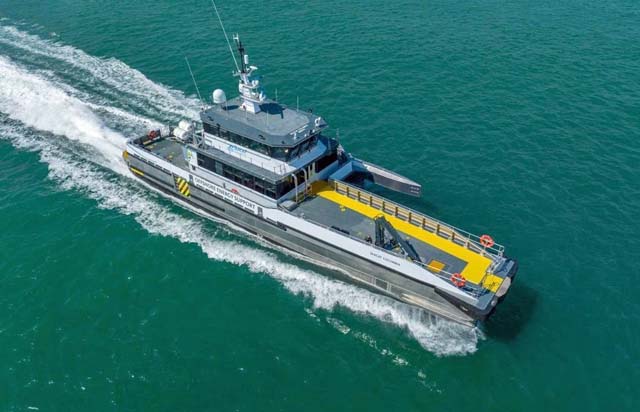Marine engineering consultancy BAR Technologies (BAR), is to make its low emission CTV design, the BARTech 30, available for the first US offshore wind projects in 2024, following tenders from several US shipyards.
BAR is setting up license agreements that will see the type manufactured in the US in 2023. As the nascent US offshore wind industry starts to firm up project timeframes, BAR has identified an opportunity for it to capitalise on the latest low carbon and fuel-efficient designs for offshore wind workboats and crew transfer vessels, leapfrogging many of the legacy, less efficient designs that have stemmed from European offshore wind development. With the Biden Administration targeting up to 30GW for the US offshore wind market, and with many of these projects far out to sea, the diesel fuel burn for workboat operators serving the market can be significant. More efficient CTV designs, however, that either utilise the retrofit of efficient technologies, like foiling, or encompass entirely new hull-forms, present an opportunity to save operators significant fuel costs.
Additionally, with the US offshore wind market comprising a number of European developers managing joint venture projects, the focus in the European markets on emission reduction will, in time, also become a part of the US offshore wind industry. As the US offshore wind market rapidly accelerates, there is a real opportunity to bypass some of the more drawn-out learning processes that are only now enabling more efficient, lower carbon emitting CTVs to become operational in Europe.
With significant interest in the domestic US licensing of the BARTech 30 CTV – a type already on charter at the UK’s Sheringham Shoal offshore wind farm – BAR anticipates its vessel design will be available to support the first major US offshore projects as they head into construction.
BAR CEO John Cooper said: “The US offshore wind market has huge potential, but that potential isn’t limited to the scale of its projects and rapid pace of development. Equally, there is a massive opportunity to circumvent many of the quite protracted processes for growth – and one of these is in the rapid deployment of the latest greener and leaner, workboat vessels. In the European markets, a number of forward-thinking wind farm operators are recognising not only the significant opportunity to reduce fuel burn across the fleets serving their projects, but also the reputational risk in continuing to use outmoded inefficient vessel designs. With some of these same operators now developing projects in a new market, we anticipate a number will be looking to capitalise on some of the innovations they have in Europe, in the US.”
With its 30m ProA design, and active foiling systems to correct for pitch and roll, the BARTech 30 is able to minimise vessel motion and fuel burn – leading to an average increase in stability across all sea states of up to 70% and a reduction in total emissions of 30% over a typical operational profile – making the vessel one of the first Low Emission Vehicles (LEVs) serving offshore wind farms. Additionally, with the vessel able to operate in more challenging conditions than the current catamaran designs, offshore wind turbines may be serviced over a greater number of sea states, ensuring wind farm owners have more opportunities to better and more cost effectively provide turbine maintenance.



